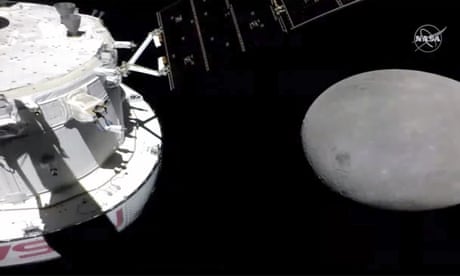- by foxnews
- 08 Apr 2025
Nasa’s Orion capsule reaches moon on way to record-breaking lunar orbit
Nasa’s Orion capsule reaches moon on way to record-breaking lunar orbit
- by theguardian
- 22 Nov 2022
- in news

Nasa checked off another crucial milestone on its first crew-capable moon mission for 50 years early on Monday with the Orion capsule of Artemis 1 "buzzing" the moon as it made its closest approach to the lunar surface of the 25-day space flight.
The pass, 81 miles above the far side of the moon, was followed by a critical engine burn to place the spacecraft on a pathway to a wide lunar orbit 40,000 miles further on, the farthest a human-rated vehicle has ever traveled from Earth.
Mission managers in Houston had to wait 30 minutes to find out if the engine firing was successful, because of a communications technical blackout while it was on the dark side of the moon. But Nasa officials tweeted confirmation shortly afterwards, revealing that Orion's flyby speed of 5,102mph had increased a further 580mph as a result of the burn.
Nasa also released closeup images of the moon, taken by Orion on its approach, and a still showing the capsule, moon and Earth in the same frame.
The pass came 53 years to the day since three astronauts aboard Apollo 12, the second of Nasa's six moon landings between 1969 and 1972, left lunar orbit to return home, the agency's history office said.
It is the first time a capsule has visited the moon since Apollo 17 in 1972, and represented a huge milestone in the $4.1bn test flight that began last Wednesday after Orion launched
Orion's flight path on Monday, about 232,000 miles from Earth, took it over the landing sites of Apollo 11, 12 and 14 - humankind's first three lunar touchdowns.
The moon loomed ever larger in the video beamed back earlier in the morning, as the capsule closed the final few thousand miles.
"This is one of those days that you've been thinking about and talking about for a long, long time," flight director Zeb Scoville said while waiting to resume contact.
As the capsule swung out from behind the moon, onboard cameras sent back a picture of Earth, a blue dot surrounded by blackness.
Orion needed to slingshot around the moon to pick up enough speed to enter the sweeping, lopsided lunar orbit.
This weekend, Orion will shatter Nasa's distance record for a spacecraft designed for astronauts - nearly 250,000 miles from Earth, set by Apollo 13 in 1970.
And it will keep going, reaching a maximum distance from Earth next Monday at nearly 270,000 miles.
The capsule will spend close to a week in lunar orbit, before heading home. A Pacific splashdown is planned for 11 December.
Orion has no lunar lander. A touchdown will not come until Nasa astronauts on Artemis 3, including the first woman to walk on the moon, make an attempt scheduled for 2025 on SpaceX's Starship HLS (human landing system). Before then, however, astronauts will strap into Orion for a ride around the moon as early as 2024.
- by foxnews
- descember 09, 2016
Ancient settlement reveals remains of 1,800-year-old dog, baffling experts: 'Preserved quite well'
Archaeologists have recently unearthed the remarkably well-preserved remains of a dog from ancient Rome, shedding light on the widespread practice of ritual sacrifice in antiquity.
read more


